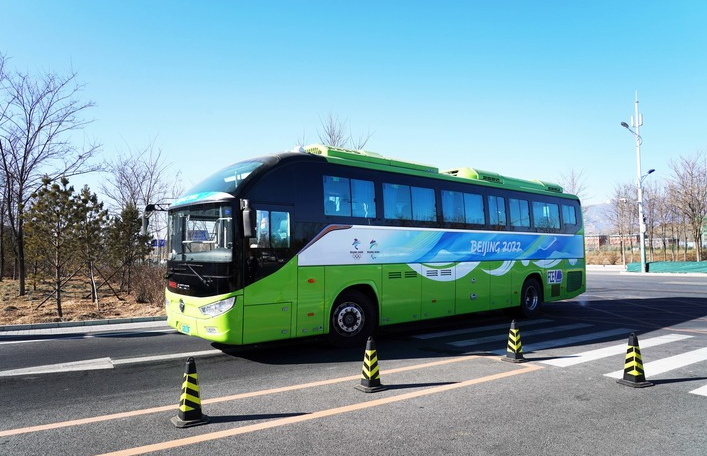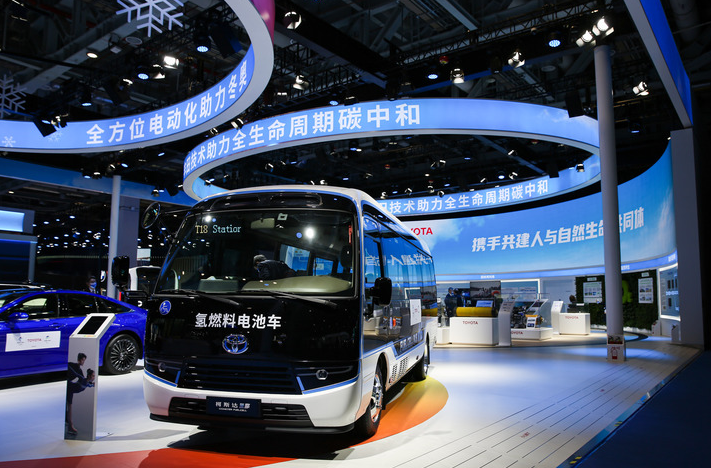Development observation of hydrogen fuel cell vehicle industry
Author:Xinhuanet Time:2022.09.29
Xinhua News Agency, Beijing, September 29th: Observation of the development of hydrogen fuel cell vehicle industry
Xinhua News Agency "Xinhua View Point" reporter Huang Xing, Lu Hao, Wang Moling
According to data released by the China Automobile Industry Association, from January to August this year, the production and sales of fuel cell vehicles in my country have completed 2,000 vehicles, a year -on -year increase of two and 1.6 times, respectively. Among them, the output in the first half of the year has exceeded the whole year, and the development of the hydrogen fuel cell vehicle industry has accelerated significantly.
In recent years, the state has introduced a number of policy documents involving hydrogen energy and hydrogen fuel cell vehicle industry. In March of this year, the National Development and Reform Commission and the National Energy Administration jointly issued the "Medium Long-term Plan for the Development of the Hydrogen Energy Industry (2021-2035)", which proposed that the amount of hydrogen fuel cell vehicles would be about 50,000 by 2025.
Hydrogen fuel cell vehicle frequently "debut"
In July, Changan Deep Blue released the first mass -produced hydrogen fuel cell sedan -SL03 hydrogen electricity version, which realized 100%of the core components of the vehicle, with a maximum range of 730 kilometers.
"We will centralize production after receiving some orders, and plan to deliver the first batch of users before the end of the year." Liu Zhengxing, Director of Changan Deep Blue Project, told a reporter from "Xinhua Vision" that Changan Automobile will also launch 2 to 3 in the next 3 to 5 years. Hydrogen fuel cell passenger car.
In addition to the listing of Changan Deep Blue SL03 hydrogen electricity version, SAIC Chase Maxus Euniq7 realizes mass production; Hippocampus 7X-H real car is also officially unveiled, and the new car positioned hydrogen fuel cell MPV. In addition, a number of car manufacturers will also launch hydrogen fuel cell vehicle products.
Unlike the policy support of pure electric vehicles "purchase subsidies", my country mainly relies on the policy of hydrogen fuel cell vehicle demonstration urban agglomeration to promote the promotion and application of hydrogen fuel cell vehicles. Since August 2021, the state has clearly listed urban agglomerations in Shanghai, Beijing, Guangdong, Henan, and Hebei as national hydrogen fuel cell vehicle demonstration application urban agglomerations. These areas have accelerated demonstration operations in these areas to drive the development of the industrial chain.
In January of this year, Huangpu District, Guangzhou, officially invested in operating 500 hydrogen fuel cell mud heads for transportation for construction waste. These mud header can complete hydrogen charging in 8 to 15 minutes, with a range of more than 400 kilometers. So far, the operating mileage of these mud heads has exceeded 600,000 kilometers.

On January 17, hydrogen fuel new energy vehicles were prepared to enter the Beijing 2022 Winter Olympics and Winter Paralympic Games Yanqing Insurance Center Station. Xinhua News Agency reporter Ren Chao Photo
During the Beijing Winter Olympics and the Winter Paralympics this year, more than 1,000 fuel cell vehicles achieved large -scale demonstration operations, proved the application technology and economic feasibility of fuel cell vehicles under the condition of minus 20 degrees Celsius in winter.
In early August, 410 SAIC fuel cell vehicles were officially put into commercial operations, including passenger cars, passenger cars, logistics vehicles, heavy trucks and other models. The "Shanghai Hydrogen Energy Industry Development (2022-2035)" issued this year clearly states that it will accelerate the commercial application of hydrogen fuel cells in the transportation field, and by 2025 fuel cell vehicles will exceed 10,000.
Some core technologies continue to break through, and the industrial chain has accelerated the formation
What is the maturity of hydrogen fuel cell vehicle technology as a technical route that is different from electric vehicles?
The reporter learned that the core technologies of the hydrogen fuel cell vehicle industry are concentrated in hydrogen fuel cell piles, etc., mainly include "three major materials" such as catalysts, proton exchange membranes and carbon paper, as well as "two major components" such as bipolar boards and membrane electrodes. Essence At present, the core technologies of these areas have continued to break through to accelerate domesticization.
The membrane electrode is called the "chip" of hydrogen fuel cells, which determines the performance, life and cost of hydrogen fuel cells. In recent years, with the joint efforts of domestic enterprises and scientific research institutions, localization has significantly accelerated.
Other parts and components have also accelerated the "break". The Advanced Energy Industry Research Institute (Guangzhou) Co., Ltd. has created a carbon paper production line with an annual output of 30,000 square meters. In the entire vehicle session, the biggest constraint facing hydrogen fuel cell passenger cars was too large and weight of hydrogen fuel cells, but with the significant increase in power density of hydrogen fuel cell piles in my country, and the level of domestic parts and components gradually increased, the above technologies mentioned above. The problem achieves breakthroughs. For example, the fuel cell system pipeline beam in Changan Deep Blue SL03 hydrogen power version decreases by about 20%, and the system volume is significantly reduced, making it possible for cars to be equipped.
"In recent years, various indicators of hydrogen fuel cell vehicles in my country have improved to varying degrees. For example, the life of the pile of graphite bipoire has been increased from 3,000 hours to 15,000 hours." Ouyang Minggao, an academician of the Chinese Academy of Sciences.
The reporter learned that the hydrogen fuel cell vehicle industry chain is relatively long, involving the upstream hydrogen, hydrogen storage, hydrogenation, to the manufacture of components such as fuel cell systems, electrical drive systems, and extending to logistics, travel, etc. Class application scenarios. At present, the hydrogen fuel battery vehicle industry chain is accelerated in many places across the country.

Hydrogen fuel cell vehicles shot at the 4th Expo Auto Shin. Xinhua News Agency (Photo by Hao Zhao)
Huangpu District, Guangzhou is a demonstration zone in the commercial operation of hydrogen fuel cell vehicle in Guangdong Province. It has settled in more than 40 upstream and downstream enterprises and institutions in the local area. It is expected to exceed 1 billion yuan in 2022. In order to improve the industrial chain, Guangzhou has also accelerated the production of hydrogen energy. The annual output of 1500 tons of high -purity hydrogen projects in Guangzhou Petrochemical will be completed and put into operation. By 2025, it will form an annual output of more than 20,000 tons of vehicle hydrogen supply capacity.
In Chongqing, a number of car companies have successively launched hydrogen fuel cell models and gathered a number of key supporting companies in industrial chain. The local Sichuan also created the "Chengdu -Chongqing Hydrogen Corridor" and planned to invest about 1,000 hydrogen fuel cell logistics vehicles by 2025. Focusing on the entire industry chain, Chongqing has also accelerated the construction of the National Hydrogen Energy Quality Inspection Center project and built a comprehensive operation monitoring platform for hydrogen fuel cell vehicles. Still in the initial demonstration and business model exploration stage
"The hydrogen fuel cell vehicle industry is still in the initial demonstration and business model exploration stage, and it takes time to drive industrial development." Xu Haidong, deputy chief engineer of the China Automobile Industry Association.
High cost is the core issue. According to relevant estimates, the average unit price of each hydrogen fuel cell vehicle power system is hundreds of thousands of yuan, while the battery cost of the electric vehicle power system is only tens of thousands of yuan, and the fuel vehicle power system is even less than 10,000 yuan.
Electrolytic water is one of the most promising hydrogen preparation methods, but the current cost of hydrogen -making is still high. According to estimates, the current cost of hydrogen fuel cell vehicles per 100 kilometers is 30 to 80 yuan per 100 kilometers, while electric vehicles consume the power per 100 kilometers.
People in the industry suggested that they still need to carry out key core technologies such as hydrogen fuel cells and electrolytic devices, and accelerate the improvement of the industrial chain and related supporting facilities. Fan Weiyao, general manager of Shanghai Lanze Energy Technology Co., Ltd. believes that it still needs to promote the research and development of core components such as carbon paper and proton exchange membranes to accelerate the process of domesticization.
The hydrogen fuel cell passenger car served by the Boao Forum for Asia 2021 will add hydrogen in Sinopec Qionghai Yinfeng prying the hydrogenation station. Photo by Xinhua News Agency reporter Pu Xiaoxu

The industry believes that as the hydrogen fuel cell passenger cars accelerate the market and drive on the road, it is more dependent on the complete hydrogen refueling network network. At present, it still needs to accelerate the pace of construction such as hydrogen refueling stations.
Li Rongjun, deputy general manager of Xiongchuan Hydrogen Energy Technology (Guangzhou) Co., Ltd., believes that compared with pure electric vehicles, hydrogen fuel cell vehicles have short injection time and long range of mileage. Congenital advantages should be promoted and applied in the fields of heavy -duty vehicles, special vehicles, commercial vehicles, energy storage and other fields to drive the development of the entire industry chain.
- END -
President Uruguay's letter: I look forward to Henan can become Uruguay meat products and soybeans in China in China

[Dahe Daily · Dahecai Cube] (Reporter Yang Xiao intern Bu Yingchen reporter Zhu Z...
Both \"planting farmland\" and \"planting landscape\" Yijiang held the Qiu f
Hai Huaihua News Show Shi Shi and Mangye, all the four fields were inserted. On June 6, in the Qiu Tian Group of Niuyuping Village, Niu Ping Township, Daijiang Dai, a seedlings of \helping the coun